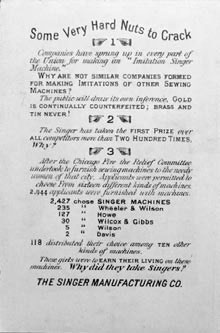
figure 1
Some Very Hard Nuts to Crack
Early Singer Trade Cards
Trade cards became popular in the 1870s for local and national advertising. Locally, an agent could use them as a business card to leave with customers and, nationally, they helped to establish a brand.

figure 6
The Singer Obelisk
In the 1870s and 1880s, the Singer Company was expanding rapidly in its bid to "peacefully conquer the world". The company organisation was very centralised with the district managers reporting directly back to Elizabeth, NJ. The managers were salaried employees, as were the 'canvassers' who received a small salary plus commission of sales achieved. The canvasser was responsible for sales, delivered the machine, instructed the buyer in its use and collected the first payment. Below the 'canvassers' were the 'collectors' who collected the weekly payments and remitted them to the local manager.
Looking at the trade cards we find advertising cards for the Singer Company to be used everywhere, business cards for the local managers and, in the early days, cards for the canvassers. Whilst there were company cards, managers seem to have been able to design cards for local use and to use local printers. When F. G. Bourne took over the Presidency of the Singer Manufacturing Company in 1889 he determined to further integrate the operation and, in 1892, set up a single Head Office department to organize advertising and publicity. The first themed series of trade cards were the 36 cards of the 'costumes of all nations' issued for the Columbian Exposition of 1893. After that cards appeared mostly in series, or to commemorate particular events. The quality of lithography used was much improved and the local manager or canvasser was restricted to a rubber stamp to be imprinted where the card helpfully read "presented by".
A look at some early series
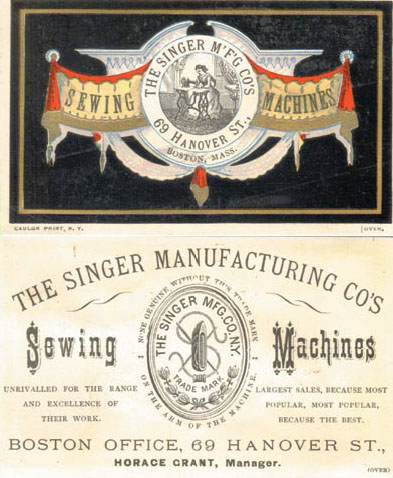
figure 9
Business card for Horace Grant

figure 7
The Great Suspension Bridge - Have You a Singer Sewing Machine?

figure 8
Adelina Patti
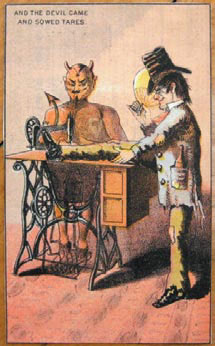
figure 2
And the devil came and sewed tears

figure 3
What I have sewed together let no-one rip asunder
The great Chicago fire of 9th October 1871 devastated the city. The 'Relief and Aid committee' worked to help the poor get back to work until 1874, providing artisans with tools. The Singer Company capitalised on this in their series Some Very Hard Nuts to Crack (Fig. 1 shows the back which was common to all cards). The fronts of the cards bear a variety of pictures, many of which contain the most cringe-making puns (Figs. 2, 3, 4). Other card fronts show famous buildings erected during the 1870s (Fig. 5).
In 1878 'Cleopatra's Needle', an ancient obelisk shipped from Egypt, was erected on the Victoria Embankment in London. Not to be outdone, New York acquired its ancient Egyptian obelisk in 1880. Taking an interest in the Egypt of the Pharaohs was fashionable and Egyptian motifs appeared on all sorts of goods. The Singer Company changed the backs of its series of trade cards to 'The Singer Obelisk' (Fig. 6) although many of the pictures on the fronts remained the same. New York landmarks, such as the 'Great East River Bridge' or the Brooklyn bridge (1883) and the Statue of Liberty (1887), were commemorated (Fig. 7).
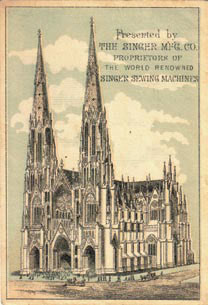
figure 5
St. Patrick's Cathedral, NY

figure 4
As ye sew so shall ye rip
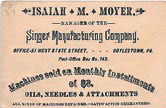
Figure 10
Business card for Isaiah Moyer
Another series of the 1880s featured portraits of famous classical singers: some, like Minnie Hauck, were little known outside America; some, like Adelina Patti, were famous worldwide (Figure 8).
The company had a standard business card for the managers of major branch networks. Fig. 9 shows the one for the 1870s. It is printed on quality card by a well known printing company. The managers of smaller branches used cards which look as though they were done cheaply by the local jobbing printer using as many typefaces as possible (Fig. 10). Others show that staff handled other goods than sewing machines; selling other makes of sewing machines was forbidden (Figs. 11, 12).
In the late 1880s there seem to be a lot of cards which fit no real pattern so the time was ripe for the new President to impose some corporate view on trade cards (Figs. 13, 14, 15).
There are over one thousand to find between 1870 and 1940. Happy collecting!
Martin Gregory
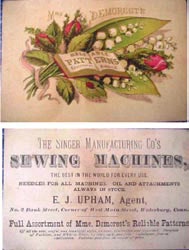
figure 11
Canvasser's Card
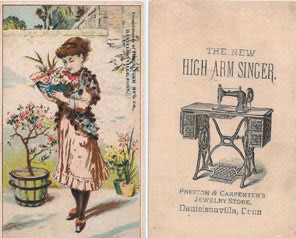
figure 12
Canvasser's Card

figure 15
Misc. cards c.1890
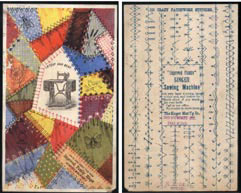
figure 13
Misc. cards c.1890
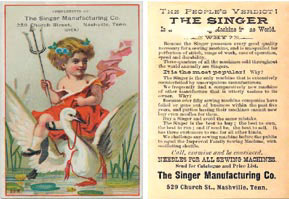
Misc. cards c.1890






